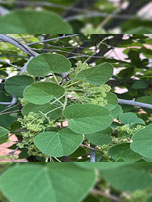SHAHEED KARTAR SINGH SARABHA AYURVEDIC MEDICAL COLLEGE & HOSPITAL
Affiliated to Guru Ravidas Ayurved University, Hoshiarpur Punjab
Affiliated to Guru Ravidas Ayurved University, Hoshiarpur Punjab

Botanical Name : Cissampelos pareira Linn
Family : Menispermaceae
Introduction :
In North india Cissampelos pareira used as patha, in south Cyclea peltata used as patha. It is one of the best brain tonic used in Ayurveda along with other drugs. In the Vedic literature Pãthã is described as ‘Pãtã’
Names in different Indian languages :
English : Velvet-Leaf Pareira, PareiraBrava.
Malayalam : malathaghi
Tamil : Paadakkizhangu, Appatta.
Unani : Paathaa
Synonyms :
Paathaa, Ambashthaa, Varatiktaaa, Vriki, Aviddhakarni,Piluphalaa, Shreyashi
Classification according to Charaka, Susrutha & Vagbhata :
Charaka
Sandhãniya, Jvarahara, Stanyasödhana
Susrutha
Mustãdi, Aragvadhadi, Pippalyadi, Ambasthadi, Brahatyadi, Patolädi
Vagbhata
Mustadi, Aragvadhadi, Ambasthdi, Patolädi, Vatsakãdi
Varieties & adulterants – (CV – controversy, AD – adulterants) :
1. Cyclea peltata – [AD]
2. C. burmani – [AD]
3. Stemphania hernandifolia – [AD]
4. Rivea hypocrateriformins – [AD]
5. R. ornata. – [AD]
6. Raja patha – Cyclea peltata
7. laghu patha – Cissampelos pariera
8. Cyclea peltata – south India
9. Stephania hernandifolia
Morphology :
It is a climbing shrub; branches pubescent.
Leaves- peltate, 3.8-10 cm diameter.
Flowers- minute, yellowish. Male flowers in axillary cymes, peduncle 18mm long. Sepals 4, hairy, obovate- oblong. Petals combined into a cyathiform corolla, half the length of the sepals. Filaments longer than Corolla. Female flowers in elongate, solitary or twin, axillary racemes; pedicles very short; bracts foliaceous or nearly sessile, orbicular or reniform. Sepal 1, ovate-oblong. Petal 1, sub rotund.
Fruit drupe, subglobose, hairy, red, endocarp transversely ridged. Distribution- Found throughout tropical & subtropical India.
C. peltata- It is a climber, Leaves- peltate, hairy,
Flowers- very small. Male flowers in panicles, very long.
Fruit- drupe. reniform.
Note— The species of this plant are easily distinguished by the cup-shaped calyx and corolla. Cissampelos has the corolla alone cup-shaped.
Distribution & Habitat :
All over India
Chemical constituents :
Hayatine, methiodide and methochloride, cissamine, pareirine, cycleanine,bebeerine, hayatidin, (+) quercitol
Properties :
RASA-tikta
GUNA-laghu, tikshna
VIRYA-ushna
VIPAKA-katu
Karma : Vata-Kaphahara, Visaghna, Grãhi, Balya
External uses :
Being wound healer. antidote and Kushthaghna, paste of leaves and root is used in purities, skin disorders and snake poison. Juice or powdered roots are used as a nasya.
Internal uses :
Digestive System : Being an appetizer, digestive, laxative, astringent and anthelmintic, it is useful in anorexia. indigestion, abdominal pain, diarrhoea and dysentery
Circulatory System : It is a blood purifier and has anti-inflammatory properly, so it is used in blood disorders, heart disorders and inflammation.
Respiratory System : Being an expectorant, is is used in cough and dyspnoea.
Reproductive System : Since it purifies breast milk it is used in various disorders ot breast milk secretion.
Urinary System : diuretic, hence useful in dysuria and haematuria.
Skin : Kushthaghna, Useful in skin disorders.
Temperature : Being febrifuge and refrigerant, it is used in jwara. fever related diarrhoea and burning disorders.
Satmikaran : Antidote and tonic – bitter tonic.
Indication :
Atisãra, Chardi, süla, Jvara, Kustha, Kandü, Krmi, Hrdroa, Gulma, Yöni röga.
Root astringent, antispasmodic (used for cramps, painful menstruation), analgesic, antipyretic, diuretic, antilithic and emmenagogue. Prescribed for diarrhoea, dysentery, piles, urogenital affections (cystitis, nephritis, menorrhagia)
Part Used :
root
Dosage :
1-2 gm
Important Yogas or Formations :
Pusyanuga curna,saddharana yoga, padathi kashaya
Therapeutic Uses :
(1) ArthaVabhedaka – Root juice of Pãtha shall be used as Nasya (G.N.)
(2) Lavanameha— Decoction of Pãthã and Aguru is useful (S.S.Ci. 11)
(3) Arsas— Pãthã is taken with butter-milk (A.H.Ci.8)
(4) Root paste is applied topically on scabies and eruptions on the body.
(5) Also used for preventing miscarriage.
